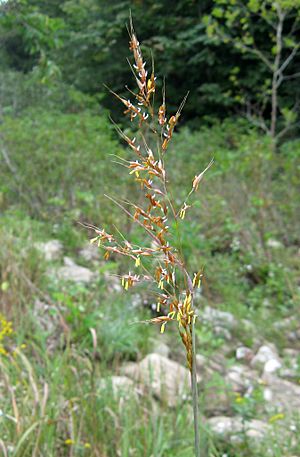Sorghastrum nutans facts for kids
Quick facts for kids Sorghastrum nutans |
|
|---|---|
 |
|
| Indiangrass in bloom | |
| Scientific classification | |
| Genus: |
Sorghastrum
|
| Species: |
nutans
|
Indiangrass, also called yellow Indiangrass, is a type of grass found in North America. It grows mainly in the central and eastern parts of the United States and Canada. You can often see it in the wide-open spaces called prairies, especially in the Great Plains. It is a very important plant in these areas.
Contents
All About Indiangrass
Indiangrass is a special kind of grass that grows back year after year. It is called a "warm-season" plant because it grows best when the weather is warm. It also grows in clumps, like a bunch of grass together. Indiangrass does not like shady places; it needs lots of sunlight to grow well.
This grass can grow quite tall, usually between 3 to 7 feet (about 1 to 2 meters) high. A cool way to spot Indiangrass is by looking at its leaves. Where the leaf connects to the stem, there's a small part called a ligule. On Indiangrass, this ligule looks like the "rifle-sight" on a gun. Each leaf can be about 3 feet (1 meter) long.
How Indiangrass Reproduces
Indiangrass blooms from late summer into early fall. During this time, it grows branched clusters of flowers called panicles. These clusters have small parts called spikelets, which are golden-brown when they bloom. Each spikelet has one perfect flower. This flower has three large, bright yellow parts called stamens and two feathery parts called stigmas.
One of the two outer leaves at the base of the spikelets is covered in soft, white hairs. The flowers of Indiangrass are pollinated by the wind. This means the wind carries pollen from one plant to another.
After the flowers are pollinated, the branches of the flower clusters bend outwards. When the seeds are fully grown, they fall to the ground. There are many seeds, about 175,000 in just one pound!
Indiangrass in Nature
Indiangrass is a very important part of the tallgrass prairie ecosystem. It grows alongside other well-known prairie grasses like big bluestem, little bluestem, and switchgrass. You can also find it in areas where longleaf pine trees grow.
This grass is found across a large part of the United States, from the southern border all the way up to Canada. It also grows from the eastern coast to states like Montana, Wyoming, and Utah in the west.
Indiangrass grows back stronger and healthier after fires. Because of this, people sometimes use controlled fires to help the grass grow. This helps keep the habitat healthy, much like large plant-eating animals (like bison) used to do naturally.
The pepper-and-salt skipper butterfly uses Indiangrass as a place for its young (larvae) to grow.
Indiangrass and People
Indiangrass is so important that it is the official state grass for both Oklahoma and South Carolina.
The USDA Natural Resources Conservation Service lists several ways Indiangrass is useful:
- It helps stop soil from washing away (erosion control).
- It provides food for farm animals (livestock).
- It helps pollinators like bees and butterflies.
- It is used to bring natural areas back to health (restoration).
- It provides a home and food for wild animals (wildlife).
See also
 In Spanish: Hierba de don Carlos para niños
In Spanish: Hierba de don Carlos para niños





